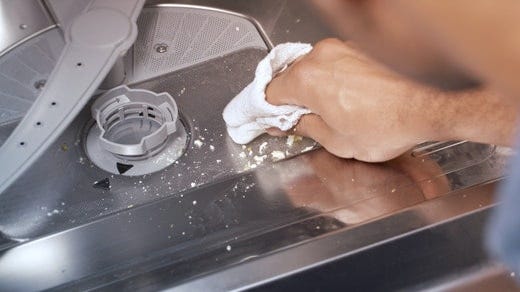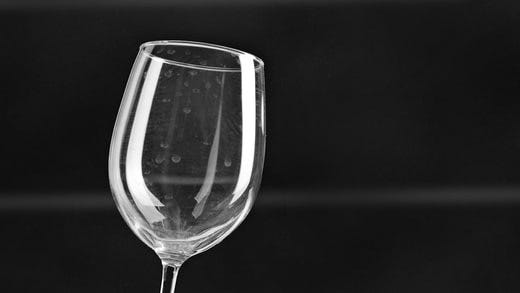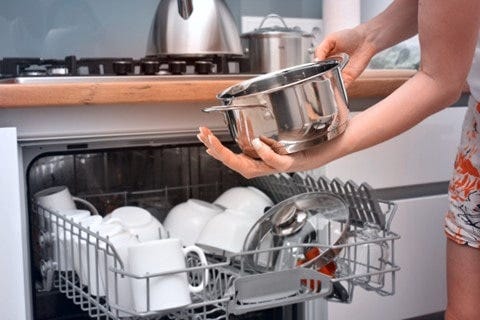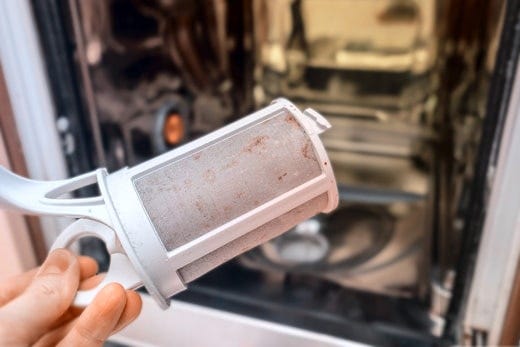
Removing hard water stains from dishwasher
Find out which products to use with Finish to remove hard water stains from your dishes and dishwasher, and ultimately extend its life cycle.

You may have heard of hard water in relation to the area that you live in. Having hard water often means that your water will taste good, but unfortunately can cause spots on glass and surfaces, as well as causing a build-up in your dishwasher that can be difficult to remove by hand. So, what is it exactly, and what do we need to do to clean hard water build up and deposits in the dishwasher?
What is hard water?
In some areas, the water that comes out of your tap seeps through deposits of limestone and chalk, which are made up of carbonates. Soft water comes when there are low traces of these compounds, whereas hard water contains relatively high levels of calcium and magnesium, as well as other minerals. There is no health risk associated with this, but as mentioned, it can lead to hard water stains and limescale build up, as well as a reduction in your dishwashing detergent’s efficiency.
How to remove hard water stains
In your dishwasher, hard water can have two results – cloudy glasses, and limescale build up. For this, you can use Finish Rinse Aid.
Finish Rinse Aid
You can use Finish Rinse Aid rinsing agent to tackle the water spots and film that come with hard-water stains for sparkling dishes, glasses and utensils in the following steps:
- Check whether your dishwasher has a built-in liquid rinse aid dispenser, which is usually located near the detergent cup(s).
- Fill your rinse aid dispenser with Finish Rinse Aid and wipe up any spilled product.
- Finish Rinse Aid is automatically released in the rinse cycle every time your dishwasher runs.
- We recommend keeping the Rinse Aid chamber always full. Check and top up monthly or, if red light blinks from your dishwasher, this is signalling low level of Rinse Aid. Please fill the Rinse Aid chamber when that happens.
Can water temperature being too hot damage your dishwasher?
Although your dishwasher water temperature needs to be hot enough for sparkling clean glasses and a thorough clean, high temperatures combined with lax maintenance can be bad for your dishwasher itself. Here are some of the problems that arise and how best to fix them:
Hot water and limescale
High temperatures mean that the natural calcium and magnesium content of water can cause limescale to form on the inside of your dishwasher. Over time, this can pose a problem, as it can hamper the efficiency of your dishwasher. To solve this, use a product such as Finish Dishwasher Cleaner once every 3 months to remove the limescale and any grease and food waste that remains. This will make sure that it looks shiny, smells fresh and most importantly, keeps your dishes as clean as possible.
Hot water and cloudy glasses
Another downside to these high temperatures is that they can make your glasses appear cloudy over time. While hot water agitates the molecules of the glass, the chemicals in the detergent can offset some of the negative effects. Although still smooth to the naked eye, these small imperfections affect the way light passes through the glass and gives them a cloudy appearance.
So, next time you’re uncertain as to whether your dishwasher is working at the optimal temperature, refer to our tips and tricks to solve the problem. Always take the necessary steps to safeguard your machine and glasses against the effects of hot water.
How to prevent hard water build up in the dishwasher
Although the above methods will help you to get rid of hard water build up in the dishwasher, it’s also important to take the necessary measures to prevent hard water from building up in the first place. Making sure that your dishwasher is regularly cleaned is the perfect way to do this – just follow our simple steps below using Finish Dishwasher Salt and Finish Dishwasher Cleaner.
Finish Dishwasher Salt
Topping up Finish Dishwasher Salt can lead to less limescale building up in your machine as it softens the water as it flows into the cleaning chamber.
-
Dishwasher salt needs to be added to an extra filter in your dishwasher. This is usually found in the base of the washing unit, as opposed to the door, but make sure to check your manufacturers guide or instruction manual to make sure.
- Open the cap and pour the salt in.
- Ensure you check the packaging to find out how much salt you will need, and it may help to use a measuring cup, and a funnel, to both measure out and supply the salt to your dishwasher.
- Once poured, replace the cap in its original place.
-
Remember to top up your dishwasher salt regularly if you notice it’s running low. In some machines, there is a red light blinking at you if salt levels are low. Ensure to top up the salt tank when that happens!
Dishwasher salt needs to be added to an extra filter in your dishwasher. This is usually found in the base of the washing unit, as opposed to the door, but make sure to check your manufacturers guide or instruction manual to make sure.
Remember to top up your dishwasher salt regularly if you notice it’s running low. In some machines, there is a red light blinking at you if salt levels are low. Ensure to top up the salt tank when that happens!
Finish Dishwasher Cleaner
- Ensure that your machine is empty and do not use any other soap or detergent.
- Place the Finish Dishwasher Cleaner bottle upside down while keeping the lid on the bottle (but, remove the sticker).
- Close the door and set the machine on its hottest cycle.
- Once the cycle is Finish-ed, remove the bottle, recycle it and your dishwasher will be at its optimum efficiency.
- Recommended usage is once every three months. However, dishwasher cleaner can be used more frequently depending on dishwasher usage and/or when bad odours or machine malfunction problem arise.
The removal of hard water stains is an important step in dishwasher maintenance. This not only means that your dishes and glasses will come out sparkling, but it means that you’ll be able to extend the life of your dishwasher, too.


